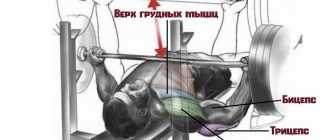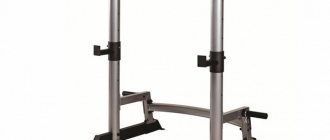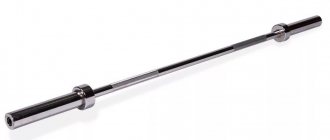Most trainees, if not all, sooner or later face the fact that the bench press is no longer growing, and do not know what can be done in this situation. Therefore, in this article we will look at 10 scientifically proven ways that will definitely improve your bench press performance.
There is a large article on the bench press on our website in which you will learn everything about this important exercise - technique, tips and variations. A must read - everything about the bench press.
Even if you have mastered the technique of this exercise and brought it to perfection, this does not mean that the weight lifted will increase over time - there are many other factors and pitfalls along the way. So let's look at a dozen strategies that will help you deal with the problem of weight gain in the bench press.
The right attitude.
Always try to monitor not only your body and nutrition, but also your thoughts - the right psychological attitude will help you achieve better results. If you perform the exercise sluggishly, thinking about something distracted, then the results will be just as sluggish - while bench pressing, enjoy the process, turn on energetic music. All this will increase your performance, but confused thoughts and general absent-mindedness will definitely reduce your performance (this is not speculation - there is research confirming this).
Another interesting and simple way is visualization. It helps a lot in training, because when you clearly see your goal and imagine it already achieved, the body automatically strives for the desired reality.
Increase weights.
There is no optimal number of repetitions that will lead to muscle building, although many still try to find this golden mean. Instead of wasting time on simple reps that don't do anything, it's better to move on to heavier weights.
What is meant by “heavy weight” in this case? The so-called “strength” rep range typically starts around 80% of your current 1RM (or 4-6 reps), and increases with your 1RM. So if you currently prefer to bench press with light weights and do, say, 10-12 reps, you can achieve more impressive results by simply moving up to heavier weights. This doesn't mean that you need to concentrate completely on heavy weights - continue to do those same 10-12 reps, but do them after sets with heavy weights.
Let's look at a theoretical workout for increasing bench press results:
1. We start with an incline bench press - warm-up, and then 2 sets of 2-3 repetitions (this is approximately 90% of 1RM).
2. Now we’ll do 3 more sets, but this time for 4-6 repetitions (about 80% of 1RM).
3. Let's move on to the dumbbell press on a horizontal bench - 3 sets of 4-6 repetitions will be enough.
4. And finally, we’ll finish the workout with a bench press – 2 sets will be enough, do as many repetitions as you are comfortable with, in the range from 8 to 12 (this should be about 70% of 1 RM).
Explosive force.
Many trainers recommend doing reps slowly, saying it helps build muscle. But a number of studies conducted at various institutes and universities around the world say the opposite.
- Scientists from the University of Sydney noted that volunteers who performed bench presses at a fast pace built muscle mass faster than those who followed the recommendations of trainers and preferred a slow pace.
- In Connecticut, scientists found that the peak strength and energy levels of those who trained at a slow pace were significantly lower than those of the group who preferred a normal (fast) pace.
- Researchers from Wisconsin have shown that even beginners who train as usual end up performing better in the high jump and squat.
- And finally, scientists from Oklahoma conducted a study that proved that if you train as usual for a month, the final results will be better than if you train at a slow pace.
In addition to all of the above, scientists have long confirmed that quickly lowering the bar (1-1.5 seconds) and the subsequent explosive lifting contribute to building muscle mass to a greater extent than slow lowering (read the article on the pace of exercises).
Lowering the bar: advice from powerlifters.
There is one piece of advice that has long been known among powerlifters, but many still have not heard it. Its essence is this: when you lower the bar, imagine that you are not just letting it “fall” on you, but actually pulling it towards you quite consciously and under control. This simple tip will allow you to better control your body position and create a fairly powerful force in the vertical direction.
So as you lower the bar, you can imagine that you are trying to bend it in half. At this time, the shoulder blades should be in the correct position - brought together. The widest muscles in your back will help you create maximum vertical force when lifting a barbell, but when lifting dumbbells, the force will remain the same because you will be using some of the energy and capacity to stabilize your body during the exercise.
Exercise regularly
There are always debates among trainees about the optimal frequency of training. Researchers are more specific on this issue - if you want to get the maximum benefit from an exercise, then do it as often as possible. This is why any training program that includes deadlifts, squats and bench presses 2-3 times a week will be extremely effective.
The fact is that muscles can become stronger without external manifestations, although an increase in muscle mass is still an integral element of overall body growth. Typically, strength gains occur due to neuromuscular adaptation—muscle fibers “learn” to work more efficiently and energetically. So the more often you train, the more active the process of learning muscle fibers is, and, accordingly, the better you perform this or that exercise. If you currently practice the bench press 1-2 times a week, then increasing the number of workouts to 2-4 will definitely increase your strength. Just be careful with increasing the load - overtraining does not bring anything good.
What will help you gain weight?
First of all, you should understand that when you train for strength, your task is to force the maximum number of muscle groups to work for results. When working on mass, you purposefully load a separate muscle group so that it grows as much as possible.
Golden rule number 1 – pump your whole body
In addition to bench presses, do other basic exercises. That is, be sure to pump the rest of your body, not just your chest. The coordinated work of a large array of muscles will help you lift more weight than just one muscle group.
It happens that squats cause discomfort in the lower back, but deadlifts go fine. Then you can replace squats with leg presses. This is also a good option that makes muscle mass grow.
Practice shows that it is impossible to achieve significant progress by doing just the bench press from workout to workout. The muscles get tired and stop responding to the load.
So when a bench press program goes beyond the bench press, the chest, triceps, and shoulders are given a rest while you train the other muscles. And this is very important.
Plus, heavy exercise (like a squat or leg press) spurs the production of testosterone, which will directly affect your strength.
Rule 2 - let your muscles rest
Overfatigue negatively affects training results. If you feel that you have not yet fully recovered from your previous session, it is better to reduce the intensity of the workout and give yourself time to rest.
Overworked muscles lose 10–15% of their strength. For example, if you bench press 100 kg for 3 reps, in a state of overtraining you will bench 85–90 for the same 3 reps.
It is believed that power benching should be done once a week. But you must focus on your body. Some people bench press not 2 times a week, but 3. Some – only 1 time. Each person has their own training regime.
Rule 3 – convenient schedule and good program
Choose the optimal training regimen for yourself. It should be in harmony with your lifestyle and daily routine. Competent trainers create training programs based on the characteristics of the client’s life rhythm.
Your bench press program should include a basic strength complex and, in fact, preparatory exercises for the bench press. To increase your strength, so that there is actually an improvement and not a regression of your muscles, you need to competently train both the whole body and specifically the working muscles (chest, triceps and shoulder).
Sometimes in programs the bench press is done either 8–10 times, or three to five. Once a week like this, the second like that.
Exercises for the chest muscles include dumbbell flyes, dips, pullovers, arm extensions, etc.
It is advisable to make changes to the program once every month or month and a half.
Rule 4 – don’t try to raise the maximum at once
As usual, do 5 repetitions, or at least 3. Maximum weight for one repetition is a competition point, and for strength training it is better and safer to do several repetitions.
By lifting as much weight as possible, you run the risk of pulling something or otherwise injuring yourself. After all, when you bench press weights 5 times or even 3 times, that’s one thing. But you don’t know your one-time maximum, you can easily guess wrong and get serious damage to your muscles or joints.
Indeed, in your case, it is more important to understand how to increase weight, albeit gradually, but reliably. And don’t squeeze it out, no matter how much at a time, risking your health. You're not at a competition.
If you really want to, once a month you can arrange test drives for yourself in increments of 5–2.5 kg and with insurance. But warm up very well before doing this.
Rule 5 – Eat and sleep well
No comments here. Enough has already been said about nutrition and sleep. Let's better talk about the plateau or the state when weight does not increase.
Change your grip width periodically.
This idea also comes from powerlifters, and there is also research that shows the effectiveness of changing grip width in improving bench press performance. Scientists have confirmed that a grip that is several centimeters wider than shoulder width strengthens and develops the pectoralis major muscles. At the same time, a narrow grip turned out to be most useful for the development of triceps and shoulder muscles. So if you periodically change your grip, then several muscle groups will be “pumped up” at once, which will definitely help in mastering the bench press and improving the technique of performing it.
Accustoming yourself to different grips is quite simple - do 2-3 sets with a wide grip, and then also 2-3 sets with a narrow grip.
What muscles work during bench press exercises?
The bench press gives every athlete the opportunity to develop overall strength and endurance. Thus, it can be considered a basic upper body exercise. This exercise can be performed in different ways (on a horizontal/incline bench; wide/narrow/medium/reverse grip; tilting up/down with your head), which allows you to concentrate the load on one or another muscle.
So, what muscles are used during the bench press? In general, any variation of the bench press involves muscle groups such as the pectoral muscles (major and minor), triceps brachii, and anterior deltoid muscles. There is also a load on the abs, forearms and hands.
The bench press works the pectoralis major, elbow and triceps brachii (triceps) muscles.
Don't forget about calories.
Every time you want to complain to your friends that you can’t gain weight or get stronger, think about your diet - are you getting enough calories and nutrients?
There is one simple truth: if you decide to gain weight or build muscle in a short time, then you need to get enough calories every day. If you don’t feed your body with “building material,” then your muscles won’t grow and your weight will remain the same.
The number of calories needed is different for everyone, but usually it is somewhere around 3 thousand per day. This may seem like too much, but in reality it may not even be enough. There are many stories of people who could not gain weight at all until they started consuming 4-4.5 thousand calories per day. And every day, including days free from training.
This happens due to the fact that in some people the body burns calories too quickly in the process of life and, especially, during training. So such people need calories in huge quantities, otherwise there will be no gain in muscle mass and weight.
Just be more careful about your diet - if you eat everything, then, of course, there will be enough calories, but along with them you will get fat, which you will then have to get rid of.
Rest.
Typically, training programs do not include various “non-traditional” methods due to the lack of confirmation of their effectiveness. But one such method is still worth experimentally including in training - it’s called “rest-pause.” Its essence is this: you perform some exercise “all the way”, until muscle failure. The moment you realize that you physically cannot perform another repetition, you take a short rest. Then you return to doing the exercise again, and again train until muscle failure. Then everything goes in a circle.
This technique also comes from powerlifting, and numerous studies have confirmed that it actually helps in increasing strength and will help you press more on the bench press.
It is best to include “rest-pause” in training with heavy weights (80%-90% of 1RM). If you are using approximately 80-90% of your 1RM, you should rest no more than 30 seconds between sets. If 90% or higher is used, then you can rest for up to 60 seconds. In addition, it is not recommended to perform more than 3-4 such sets in one workout, since they require significant effort.
How to distribute barbell lifts of submaximal and maximum weights?
Naturally, if an athlete easily copes with the load presented in the table of the previous article, then the number of lifts of the barbell of submaximal and maximum weights can be increased, and vice versa, slightly reduced if the athlete cannot cope with such a load, but the number of lifts should be such as to ensure increase in results. Therefore, the number of barbell lifts of submaximal and maximum weights for each athlete at each individual stage of his training should be optimal.
Significantly exceeding the optimal number of barbell lifts of submaximal and maximum weights in snatch and jerk exercises can lead to overwork and decreased results. In this case, even if he achieves excellent athletic shape during training, the athlete will not be able to show good results in competitions, since his body will not have time to recover after a lot of work with high intensity. If an athlete does not perform enough of these lifts, he does not achieve the required athletic form.
How to distribute barbell lifts of submaximal and maximal weights in snatch and jerk exercises? – we will give a comprehensive answer to this question. In the preparatory month, the total number of lifts in snatch and jerk exercises is distributed over 4 or 3 weeks (if one of them is planned as recovery). In the competition month, lifting submaximal and maximal weights is performed mainly in the first 3 weeks.
If an athlete participated in competitions in the last week of the previous month, then the number of such lifts in the monthly training is slightly reduced, and in the 1st week they are included in a small number or completely excluded.
In the 3rd week of the competition month, up to 35% of the number of lifts of submaximal and maximum weights in snatch and jerk exercises planned for the month can be performed. An additional increase in the number of such lifts this week is advisable only through jerk exercises. In push exercises, an increase can be planned no later than in the 2nd week.
When planning lifts of the barbell with submaximal and maximum weights in snatch and jerk exercises, it is necessary to take into account that not all athletes (especially in heavy weight categories) can lift a barbell with a weight of 97.5-100% during training, although in competitions they lift a weight exceeding 100 %. Such athletes need to plan on barbell lifts of 90-95%.
The time for performing the last lifts of submaximal and maximum weights depends on the weight category and individual characteristics of the athlete. Thus, athletes of lighter weight categories lift the barbell of these weights later. All athletes require more recovery time after the clean and jerk than after the snatch.
In snatch exercises, a barbell weighing 90-92.5% is lifted in 5-9 days, 95-97% - in 6-12 days, 100% or more - 7-15 days before the start of the competition, about push exercises a barbell weighing 90- 92.5% rises 5-13 days, 95-97.5% - 7-15 days, 100% or more - 9-18 days before the start of the competition.
The increased intensity of physical and mental stress when lifting heavy, submaximal and maximal weights in large quantities creates the danger of “overtraining.” To prevent this from happening, each weekly cycle requires training that includes lifting only medium and light weights. Also add a sports nutrition product such as BCAA to your diet, and then you won’t be afraid of any overtraining, well, with reasonable loads, of course. Don’t forget about the quality of rest and the completeness of recovery. Get at least 8 hours of sleep a day, add a sauna, massage and other relaxing treatments to your schedule...
I think we were able to comprehensively tell you how to distribute barbell lifts of maximum and submaximal weights in the preparation of a weightlifter - if you have any questions, ask them in the comments.
- < Back
- Forward >
Microboot.
Chances are, to improve your bench press results, your plan is to gain muscle mass and increase strength—if so, your first priority should be to increase your lifting weight during your training. The point in this case is that if you decide to become bigger, then in any case you will have to become stronger.
One proven and good way to achieve this is to train in a certain rep range and increase the weight whenever possible. Let's say at a certain point you managed to do 5 repetitions with a particular weight - then it's time to add another 2 kg when working with dumbbells and 4 kg when training with a barbell. Work the new weight until you can do exactly the same number of reps (5 in this example). Add weight again and so on.
But it also happens that you work on one weight for several weeks and you just can’t increase it. It is at this moment that microloading can come to the rescue - the essence of this term is that you will add not 4 kg to the bar, but, say, 1 or 2.
How it works: Let's say you're stuck at 80kg for 5 reps on the bench press. You tried to bench press 84 kg, but you can’t do more than 3 reps. After that, you decided to reduce the load and returned to 81 kg. Let’s say you can do 4 repetitions with this weight – that’s already good. So, after a few weeks of working with 81 kg, you are already calmly doing the required 5 repetitions - at this point, add more weight, bringing the barbell to 82 kg.
So, sooner or later you will be able to increase your bench press numbers and bench press 84 kg, although it will take longer.
Let's go to the maximum: press one at a time
How to increase your bench press results: First of all, you need to practice regularly, experiment and be prepared to fail. You will also need a good program to increase strength. By defeat I mean “didn’t shake” or “pulled a muscle.” Such moments should not unsettle you.
When athletes prepare for strength competitions, they don't focus on working their muscles. They work for strength - and this is the main principle. What matters is how many kg you bench pressed, not what biceps you have. Body mass will follow the strength. Maybe you won’t have the same muscle definition and definition as bodybuilders, but you will still stand out from the crowd.
One-time press technique
To ultimately lift maximum weight, you need to do bench press regularly, at least twice a week.
In powerlifting, the bench press is done from a position called the bridge. This position needs to be clearly worked out in order to feel stable and confident in it.
How to get into the starting position for the press:
- We lie down on the bench. But! Instead of placing your feet on the floor, place them together at the other end of the bench.
- Bend your belly up to stretch before pressing, holding onto a barbell or bar, the fulcrum being your heels and your shoulder blades. By the way, the shoulder blades need to be brought together as much as possible.
- Now we lower the pelvis onto the bench, after that we put our feet on the floor and rest our heels.
- This is the starting position.
You can, of course, make everything simpler and immediately bend over from a lying position, but then the bridge will not be so round.
The essence of the bridge is that the distance the bar travels is less than with the body in a straight position. And the bar touches the body faster, which greatly facilitates the bench press procedure. Without a bridge, it will be more difficult to lift heavy weights. Sometimes a bench press is performed with a pause.
The exercise can be performed with or without equipment. At the moment, the largest bench press with equipment, which is included in the book of records, is 486 kg, and without it – 335 (by the way, it belongs to a Russian athlete and was done in 2020). To this day, these are the most significant weights ever lifted on this planet (officially, at least).
At first, standing on the “bridge” will be unusual, but over time you will get used to it. If you are just doing it for yourself, you don’t need a bridge, lie quietly on the bench with your back, squeeze your shoulder blades together, maintain a slight arch in your lower back and place your feet on the floor.
Please note that if the surface of the bench is slippery, the shoulder blades will corrode. The same thing will happen if you train in poor quality clothing.
When you are not preparing for a competition, but are simply working on strength, to increase your bench press you also need to consistently train at least 2 times a week.
You need to bend until you feel comfortable. Your task is not to get into a bridge, but just to force the pectoral muscles to work, and not the shoulders and triceps. Then you can bench press more.
Pay attention to your shoulder muscles and triceps.
Many people mistakenly believe that lack of progress in the bench press is to blame for underdeveloped chest muscles, but in fact this is not the case - the reason lies in the degree of development of the shoulder muscles and triceps.
The front delts take an active part in lifting the barbell from the chest, while the triceps, in turn, are activated in the upper phase of the exercise.
Naturally, it is important to understand that absolutely all the muscles necessary to perform the exercise must be sufficiently developed - pumping only the triceps or just the shoulder muscles will not help, it is important to maintain balance. Without proper development of these muscles, you will not be able to increase your bench press.
How to strengthen your shoulder muscles? Try the military press, it is considered the best exercise for strengthening the muscles we need. Do it at least once a week.
As for the triceps, the bench press with a narrow grip, the extension of the arms in a crossover or from behind the head while sitting, as well as the French press help a lot in strengthening them. 2-3 similar exercises at least once a week will help you work on your triceps.
A couple of useful exercises to increase your bench press
1. Negative presses. To perform this exercise, you will need assistants and a weight 10-20% more than your maximum. The point is that you very slowly lower the barbell to your chest, while assistants help you return it to the top. It is not recommended to do more than 3 repetitions of negative presses per set (and, in fact, many approaches are not required). You can limit yourself to 1-2 sets of 1-2 repetitions.
2. Push-ups. This exercise is based on traditional push-ups, but in this case the hands are not on the floor, but on supports. This allows you to go lower during the exercise; there will be no restrictions in the form of floor. To get the most benefit from this exercise, place your hands at the same width as when performing the bench press. Also use weights. 6-10 repetitions will be enough.
Working weight[edit | edit code]
Denis Borisov. How to choose a working weight
Working weight
- a concept in bodybuilding that characterizes the weight of the equipment with which the exercise is performed. The working weight determines the intensity of the workout and also depends on the goals: strength, muscle growth, endurance, speed, etc.
Depending on the working weight there are:
- Low intensity training - 10-40%RM
- Moderate intensity workouts - 40-80%RM
- High intensity training - 80-100%RM.
Abbreviations: 1RM
(1 maximum repetition) or
1RM
- one repeated maximum. 8RM means that the working weight is selected with which you can perform a maximum of 8 repetitions.
Percentages of the repeated maximum are also used and light weights are conditionally distinguished: 10-40%RM, medium weights 40-80%RM, heavy weights 80-100%RM.
Read more:
Training intensity
How to calculate working weight[edit | edit code]
As a rule, in bodybuilding they use 6-8 repetitions in each approach, this is the optimal number. Therefore, select a weight that you can lift 8 times, provided that the last repetition is a failure, first perform a warm-up weight with 50% of the expected working weight. The resulting figure will be the working weight. Remember that for 20% extra repetitions in trial sets, you need to increase the weight by 10%.
However, it should be noted that if you select the weight after several attempts, the final result will be lower, since the muscles will already be fatigued.
There is another less accurate method that allows you to determine your working weight.
:
Use a special calculator: https://fatalenergy.com.ru/calculators/
Calculation example:
1. You assumed that in a trial approach you can lift a 70 kg barbell 10 times. 2. Do 1 set of 7 reps with 35kg. (Warm-up set) 3. Lift the barbell as many times as possible. Let's say you got 12. 4. You lifted 20% more times than expected, which means the weight needs to be increased by 10% 5. Your approximate working weight is 77 kg. Check it out in your next workout and make adjustments.











